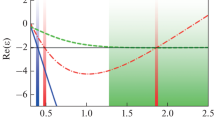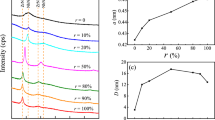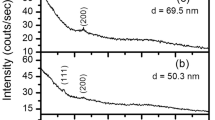Abstract
Noble metal-based nanostructures exhibit plasmonic resonance in the visible region. Search is for plasmonic materials active in other regions of electromagnetic spectrum. Alternative materials such as nitrides, carbides and semiconductors play an important role in nanophotonics as optical properties in these materials can be tuned to study plasmonic response. Also alternative materials to noble metals should have multiple properties like low optical losses, thermal and chemical stability, cost effective, easy to fabricate and also must have CMOS compatibility. Alternative materials such as transition metal nitrides fulfil these conditions up to a certain extent. In this work, optical properties of nitrides as alternative materials to noble metals are studied theoretically and compared with noble metals such as Au and Ag. Nitrides are having real part of permittivity less negative as compared to noble metals and both real and imaginary parts are extending up to infrared region. It is shown by comparison that nitrides such as TiN and ZrN are having absorption spectrum extending up to infrared region thereby making them suitable materials in the construction of devices. TiN and ZrN nanostructures show their potential for plasmonic performance in a wider spectral range than those made of Au or Ag and can act as next-generation materials for refractory plasmonics.
Access this chapter
Tax calculation will be finalised at checkout
Purchases are for personal use only
Similar content being viewed by others
References
Sturaro M, Della G et al (2016) Degenerately doped metal oxide nanocrystal as plasmonic and chemoresistive gas sensors. Acs Appl Mater Interfaces 8(44):30440–30448
Zhang R, Dong Y et al (2013) Chemical mapping of a single molecule by plasmon-enhanced Raman scattering. Nature 498: 82–86
Guo Y, Molesky S et al (2014) Thermal excitation of plasmons for nearfield thermophotovoltaics. Appl Phys Lett 105(7):073903
Pelayo García De Arquer, F, Mihi A, Konstantatos G (2015) Molecular interfaces for plasmonic hot electron photovoltaics. Nanoscale 7:2281–2288
Wan D, Chen HL, Tseng SC, Wang LA, Chen YP (2010) One-shot deep-UV–pulsed laser-induced photomodification of hollow metal nanoparticles for high density data storage on flexible substrates. ACS Nano 4:165–173
Hentschel M et al (2012) Quantitative modelling of third harmonic emission spectrum of plasmonic nanoantenna. Nano Lett 12(7):3778–3782
Derkachova A, Kolwas K (2013) Simple analytic tool for spectral control of dipole plasmon resonance frequency for gold and silver nanoparticles. Photon Lett Poland 5:69–71
Chernyshev AP (2009) Effect of nanoparticle size on the onset temperature of surface melting. Mater Lett 63:1525–1527
Losurdo M, Suvorova A, Rubanov S, Hingerl K, Brown AS (2016) Thermally stable coexistence of liquid and solid phases in gallium nanoparticles. Nat Mater 15:955–1006
Wu PC, Kim TH, Brown AS, Losurdo M, Bruno G, Everitt HO (2007) Real time plasmon resonance tuning of liquid nanoparticles by in situ spectroscopic ellipsometry. Appl Phys Lett 90:103119
Gutiérrez Y, Giangregorio MM, Brown AS, Moreno F, Losurdo M (2019) Understanding electromagnetic interaction and electron transfer in Ga nanoparticle-graphene-metal substrate sandwich systems. Appl Sci 9:4085–4090
Matula RA (1979) Electrical resistivity of copper, gold palladium and silver. J Phys Chem 8:1147–1298
Koutsokeras LE, Matenoglou GM, Patsalas P (2013) Structure, electronic properties and electron energy loss spectra of transition metal nitride films. Thin Solid Films 528:49–52
Naik GV, Shalev VM, Boltasseva A (2013) Alternative plasmonic materials: beyond gold and silver. Adv Mater 25(24):3284–3294
Boltasseva A, Atwater HA (2011) Low-loss plasmonic metamaterials. Science 331:290–291
Gbordzoe S, Kotoka R, Craven E, Kumar D, Wu F, Narayan J (2014) Effect of substrate temperature on the microstructural properties of titanium nitride nanowires grown by pulsed laser deposition. J Appl Phys 116:064310
Gutierrez Y et al (2020) Plasmonics beyond noble metals: Exploiting phase and compositional changes for manipulating plasmonic performance. J Appl Phys 128: 080901-18
Naik GV et al (2012) Titanium nitride as a plasmonic material for visible and near-infrared wavelengths. Opt Mater Expr 2(4):478–489
Guler U et al (2015) Nanoparticle plasmonics: going practical with transition metal nitrides. Mater Today 18(4):227–237
Parsalas et al (2018) Conductive nitrides: growth, optical and electronic properties and their perspectives in photonics and plasmonics. Mat Sci Eng R 123:1–55
Guler U et al (2012) Performance analysis of Nitride alternative plasmonic materials for localised surface plasmon applications. Appl Phys B 107(2):285–291
Boltasseva, Shalev VM (2015) All that glitters need not be gold. Science 347(6228):1308–1310
Patsalas P, Logothetidis S (2001) Optical, electronic, and transport properties of nanocrystalline titanium nitride thin films. J Appl Phys 90:4725–4734
Guo W-P et al (2019) Titanium nitride epitaxial films as plasmonic material platform: alternative to gold. ACS Photon 6(8):1848–1854
Mie G (1908) Ann Phys 25(3):377–445
Palik ED (1998) Handbook of optical constants of solids. Academic Press, San Diego
Baber S, Weaver JH (2015) Optical constants of Cu, Ag. Au revisited. Appl Opt 54(3):477–487
Author information
Authors and Affiliations
Editor information
Editors and Affiliations
Rights and permissions
Copyright information
© 2022 The Author(s), under exclusive license to Springer Nature Singapore Pte Ltd.
About this paper
Cite this paper
Joshi, H. (2022). Nitrides as Alternative Materials for Plasmonics. In: Krupanidhi, S.B., Gupta, V., Sharma Kaushik, A., Singh, A.K. (eds) Advanced Functional Materials and Devices. Springer Proceedings in Materials, vol 14. Springer, Singapore. https://doi.org/10.1007/978-981-16-5971-3_18
Download citation
DOI: https://doi.org/10.1007/978-981-16-5971-3_18
Published:
Publisher Name: Springer, Singapore
Print ISBN: 978-981-16-5970-6
Online ISBN: 978-981-16-5971-3
eBook Packages: Chemistry and Materials ScienceChemistry and Material Science (R0)




